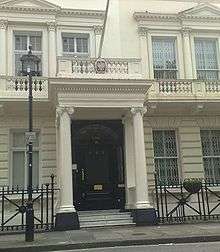Polish Institute and Sikorski Museum

The Polish Institute and Sikorski Museum (Polish: Instytut Polski I Muzeum Im. Gen. Sikorskiego), commonly known as Sikorski Institute, is a London-based non-governmental organisation of the Polish community in the United Kingdom.
It was created after the Second World War to preserve the memory of the Polish armed forces in the West and their contribution to World War II, at a time when the communist takeover of Poland made it hard and dangerous for many exiled Polish ex-servicemen and civilians to return home, and research and publication about those issues were banned or censored in the People's Republic of Poland.
In practical terms, this meant the preservation of historical records, documents, regimental colours, uniforms, insignia, works of art, literature and many personal effects which had once belonged to Polish statesmen, diplomats, academics, military leaders and ordinary men and women.
To that goal, the Sikorski institute, named after General Władysław Sikorski, has acted as a museum, archive and publishing house for much of Western Polonia and continues to function as an independent cultural and research institution.
The Institute is situated at 20 Prince's Gate in London, one of a group of Grade II listed stucco buildings facing Kensington Road and Hyde Park.[1] The museum is open from Tuesday to Friday (2pm to 4pm) and on the first Saturday of the month (10:30am to 4pm). Free tours in either English or Polish are available during opening hours.
See also
External links
- Official website
-
 Media related to The Polish Institute and Sikorski Museum at Wikimedia Commons
Media related to The Polish Institute and Sikorski Museum at Wikimedia Commons
References
- ↑ Historic England, "20 Prince's Gate (1265482)", National Heritage List for England, retrieved 14 July 2016
Gallery
.jpg) A turret gun from a Polish 7TP light tank which was used against the invading Germans in September 1939. It was later employed by the Germans in France and recovered during the allied invasion of western Europe in 1944.
A turret gun from a Polish 7TP light tank which was used against the invading Germans in September 1939. It was later employed by the Germans in France and recovered during the allied invasion of western Europe in 1944..jpg) A memorial commemorating the Polish pilots who fought in World War 2
A memorial commemorating the Polish pilots who fought in World War 2_(2).jpg) An exhibit about the Polish contribution to the Battle of Britain
An exhibit about the Polish contribution to the Battle of Britain.jpg) Remains of the 178th German plane shot down by the Polish 303 squadron during the Battle of Britain
Remains of the 178th German plane shot down by the Polish 303 squadron during the Battle of Britain.jpg) A memorial commemorating the Polish men, women and children deported and starved to death on Russian soil during and after World War 2
A memorial commemorating the Polish men, women and children deported and starved to death on Russian soil during and after World War 2- File:The Polish Institute and Sikorski Museum (23768948689).jpgA portrait of Władysław Sikorski by Kathleen Mann
.jpg)
.jpg)
.jpg) Original manuscripts by Polish poet Adam Mickiewicz
Original manuscripts by Polish poet Adam Mickiewicz.jpg) The Władysław Anders room
The Władysław Anders room.jpg) The Władysław Anders room
The Władysław Anders room_(2).jpg) A bust of Władysław Anders
A bust of Władysław Anders.jpg) A souvenir from the Battle of Monte Cassino
A souvenir from the Battle of Monte Cassino.jpg) A sculpture of Wojtek the soldier bear by David Harding
A sculpture of Wojtek the soldier bear by David Harding.jpg) A plaque commemorating the 50th anniversary of the Warsaw Uprising and Operation Tempest
A plaque commemorating the 50th anniversary of the Warsaw Uprising and Operation Tempest.jpg) A bust of Jan Sobieski
A bust of Jan Sobieski.jpg) A Polish hussar helmet from the 17th century
A Polish hussar helmet from the 17th century.jpg) The emblem of the 1st Polish Armoured Division
The emblem of the 1st Polish Armoured Division.jpg) A photo showing soldiers of the 1st Polish Armoured Division under the command of General Stanisław Maczek accepting the surrender of the German naval base in Wilhelmshaven on 5th May 1945
A photo showing soldiers of the 1st Polish Armoured Division under the command of General Stanisław Maczek accepting the surrender of the German naval base in Wilhelmshaven on 5th May 1945
Coordinates: 51°30′5″N 0°10′24″W / 51.50139°N 0.17333°W